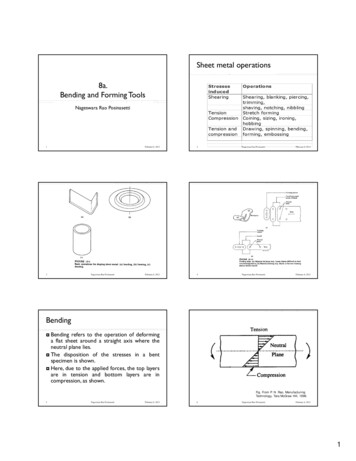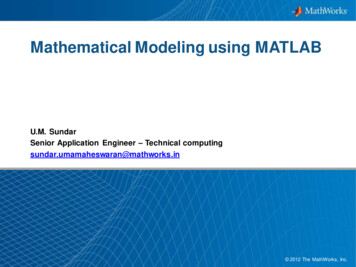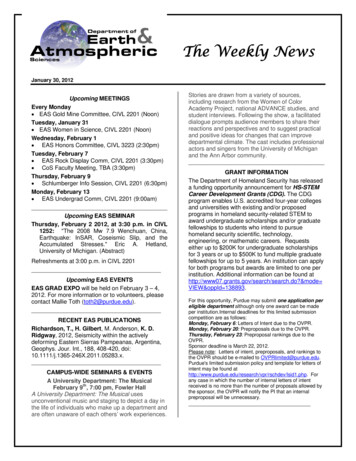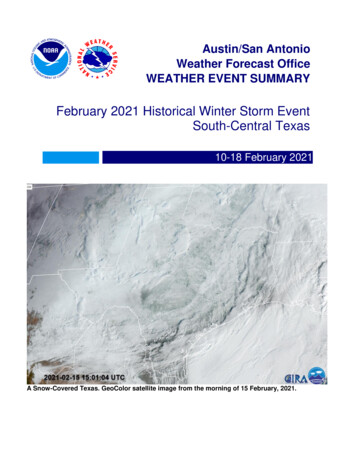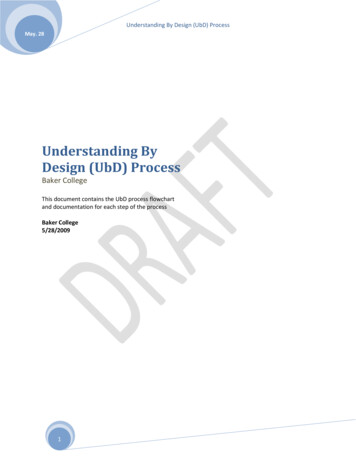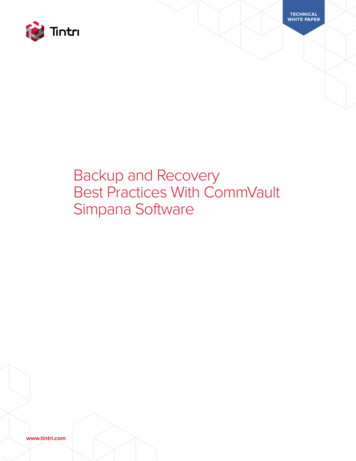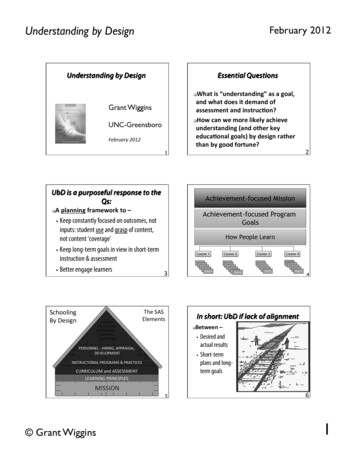
Transcription
February 2012Understanding by DesignUnderstanding by DesignEssential oesitdemandofassessmentandinstruc7on?q educa7onalgoals)bydesignratherthanbygoodfortune?q Grant WigginsUNC-GreensboroFebruary20121UbD is a purposeful response to theQs:q Achievement-focused MissionAplanningframeworkto–Keep constantly focused on outcomes, notinputs: student use and grasp of content,not content ‘coverage’§ Keep long-term goals in view in short-terminstruction & assessment§ Better engage learnersAchievement-focused ProgramGoals§ SOURCEALLOCATION2How People Learn3TheSASElementsCourse 1Course 2Course 3Course 4unit 1unit 2unit 3unit 4Unit 4unit 1unit 2unit 3unit 4unit56Unitunit 1unit 2unit 3unit 4unit 5unit 2unitunit12unit 3unit 4Unit 74In short: UbD if lack of alignmentq Between–Desired andactual results§ Short-termplans and longterm goals§ PERSONNEL- LESMISSION5 Grant Wiggins61
February 2012Understanding by DesignThe 3 big ideasIdea #1The point of education is effective understanding,not prompted recall of contentThe point of education is effective understanding,not prompted recall of contentUnderstanding using content effectivelyfor transfer & meaningUnderstanding using content effectivelyfor transfer & meaning‘Backward’Design: from engaging workand competent understanding, not ‘coverage’‘Backward’Design: from engaging workand effective understanding, not ‘coverage’7How would you complete thissentence?8i.e. Content is a contentlearned,to.q 9For what valued abilities?10The big ideas - #2The point of education is effective understanding,not prompted recall of contentUnderstanding using content effectivelyfor transfer & meaning‘Backward’Design: from engaging workand effective understanding, not ‘coverage’11 Grant Wiggins122
February 2012Understanding by DesignWhat is real understanding?How does it differ from ‘knows alot’q Ifyoureallyunderstandyoucan.q Group the ucanonly.q Ifyoureallyunderstandyoucan.ConnectAnalyzeNot justPlug inTeachAdaptCreateSay whyInterpretFigure OutApply1413What is real understanding?(Harvard Science Profs & Grad Stdts)Formal languageq Ifyoureallyunderstandyoucan.q Ifyoureallyunderstandyoucan § Make Meaning§ Transfer§ § § § 15Essence of Backward ucanonly § § § You can perform the steps but notexplain why or why better/worsePlug in, can’t adaptDon’t know where your limits are –(Socrates)16Essence of Backward idence,THEN learning?17 Grant Wiggins§ Apply what you’ve learned newcontextYou can prove somethingYou can distinguish normal fromabnormal resultsDesign a solution to your problemHave a fruitful intuitionEffectively teach it e.g. good analogiesConsistently good performanceq 2:IF THEN Ifthat’sthegoal,whatfollowsforassessment?S3:IF THEN ppropriatelearningac7vi7es?183
February 2012Understanding by DesignSome assessment ImplicationsCan’tover- ‐relyonmul7ple- ‐choice:theycannotgetatuseorcomplexmeaning- ‐makingq eededq IncreasinglynovelchallengesinvariedcontextsSome Instructional ua7onsq tstotransfer q rs,labs20q q 19Some Instructional ImplicationsSome Instructional vework,eveninlargegroupsq § q Clinical education in law and the broaderdisconnect between legal education and lawpractice.§ The swift and dramatic overhaul of medicaleducation in the last 30 years to PBL§ Washington Post article on undoing oflectures at MIT, Johns Hopkins, etc.§ aGR story.html§ Eric Mazur of Harvard video on Youtube§ http://www.youtube.com/watch?v WwslBPj8GgI21Acquisition tsanddiscreteskillsq ectiveLearningq Acquire23 Grant pedagogy244
February 2012Understanding by DesignMakeMeaningTransferMeaning dskills–q § Transfer ecificandrealis7csitua7onsandcontextsq AIM:efficient,effec7vesolu7onsforreal- ‐worldchallenges,audiences,purposes,sedngs26q e.g. interpret, gist, main idea, thesis, empathize,critique, tandings’q 25Not a new idea: Bloom -TMA dge,noristheproblemold- .q llsareneededtoachievetheselonger- ‐termgoals?q 2728TMA in PhysicsTMA in cing Grant Wiggins29305
February 2012Understanding by DesignTMA in GeographyTMA in tures,etc.)M:Makesenseofvariedandnewly- e,graph,andsolvenon- phofalinefromalinearequa7on,etc.32Thus, the course is not the textbookq THUS: Prioritize use of houldbe–Thetextbookisaresourceq It is jam-packed, to be sold in 50 states!§ Like an encyclopedia & dictionary, it providestopically organized content§ highlighted?§ skimmed?§ skipped?§ Re-sequenced?§ meaning- ive.q s?34q Try again: aim for explicitunderstandingq Backward from Goals: s:q The Constitution§ The 3 branches of government§ § Design a school governmentNo - not a goal - this just sayswhat the content is35 Grant Wiggins§ Design a government for Iraq§ Organize their workplace§ Support candidates who understand our coreprinciples366
February 2012Understanding by DesignBackward from Goals: MeaningHowever ,now&inthefuture–q .q ousayinthewayswedescribed‘understanding’aboveq The Constitution is a solution, based oncompromise, to real problems of balance andlimit of powers§ The compromise has a long, sometimes bitterhistory – with many fights that are with us andwill always be with us.37§ 383940An example of unit design: mathWhatisfair?Howcanmathhelp(ornot)?q § When we say something is ‘fair’ or ‘unfair’what do we mean? How ‘mathematical’should our evidence be?§ Students generate, categorize examples of “That’s fair!”and “That’s not fair!”41 Grant Wiggins427
February 2012Understanding by DesignNext: further discussions“What is Fair? Can math help?”q Problem - Four 7th-gradeclasses had a race of all thestudents.Jigsawonfairness§ IN GROUPS: Devise at least 2different ways to determinea fair ranking of the classes,given the results.§ Then, agree on the most fairway, and be prepared todefend your answer § § Individual ranking of runnersin a race by all 7th-gradeclasses43The content is learned - “just intime”Final assessment einthisclass.q “Guys,mathema7cianshaveafewtoolsthatmighthelpus ”q § § Lessons on measures of central tendency:§ Meanq § ModeQuizzes to check for skill§ 45In short, if you have effectiveunderstanding, you are able to –When should you and shouldn’t you use mean, median,mode?46The deeper and more smuchlearningaspossible’–by‘design’q q 47 Grant WigginsHow should everyone’s grade be calculated? Why is yoursystem more fair than the current system (or: why is thecurrent system most hatisn’tfair?§ Median§ What do we mean when we say that the rules of a game ofchance are “not fair”? What role does math play in ourjudgment?Why is it fair to have one person cut the cake and the otherperson to choose the piece?When is straight majority voting “fair” and when is it “notfair”?When is it “fair” to consider an “average” in rankingperformance (e.g. salaries, home prices, batting average) andwhen is it “unfair”?44488
February 2012Understanding by DesignThe big ideas - #3Essence of Backward Design:The point of education is effective understanding,not prompted recall of contentUnderstanding using content fortransfer & meaning‘Backward’Design: from engaging workand competent understanding, not ‘coverage’49What we typically(incorrectly) sfer,meaning,acquisi7on]50KEY: 3 Stages of(“Backward”) DesignStage1: Identify goals – the uses of content(T)and meaning-making (M) sought, and theenabling skill & knowledge (A) neededIdentify the topics and content to be coveredDetermine how you will teach the contentStage 2: Determine the most appropriateassessment evidence of STAGE 1 TMA GoalsWhen grades are due, assessthe learning of the contentStage 3: Determine the most appropriate learningactivities and instruction, given the goals (ST1)and evidence (ST2)51Consider: goal of Driver’s Ed – evenwith limited timeConsider:q Thegameq Thedrills53 Grant Wiggins52549
February 2012Understanding by DesignHint: not a good way to learn todrive.Backward Design: clarifyassessments first!Stage1: Identify goals – the uses of content andmeaning-making sought, and the enabling skill &knowledge neededStage 2: Determine the most appropriateassessment evidence of STAGE 1 GoalsStage 3: Determine the most appropriate learningactivities and instruction, given the goals (ST1)and evidence (ST2)5556Questions for TESTING the validityof assessmentsThink like a judgeIstheevidenceappropriate?q Istheevidenceconvincing?q competence‘beyondareasonabledoubt’?Could the proposed ‘test’ be done well - withoutSTAGE 1 being accomplished or furthered?§ Could the specific test result be poor, but it beplausible that the student might still really haveachieved STAGE 1 satisfactorily?§ q bothq 57Backward Design: the activitieshave to yield successfulperformanceTip: Infer Goals from theAssessmentsStandard(s):STAGE 1: Desired Resultsstage1stCoverStage1What do the assessmentssuggest the goals must be?PerformanceTSTAGE 2: Assessment Evidenceask(s):Other Evidence:Stage1: Identify goals – the uses of content andmeaning-making sought, and the enabling skill &knowledge neededStage 2: Determine the most appropriateassessment evidence of STAGE 1 GoalsStage 3: Determine the most appropriatelearning activities and instruction, given the TMAgoals (ST1) and evidence (ST2)2STAGE 3: Learning Plan Grant Wiggins58596010
February 2012Understanding by DesignWhat’s the best use of precious classtime?Whatcanonlyorbestbedoneinclasstogether?q Whatisthemostengagingandthought- ‐provokingwaytouseclass7me?q Whatcan’tbefoundforfreeontheInternet?To put it eryofinforma7on?q q 6162Transfer Meaning - independentlylearningIdo,youlisten&watchq Ido,youhelpq Youdo,Ihelpq Youdo,Ilisten&watch§ The ‘gradual release’ model is a general schemafor the development of independent mastery atany age, in any subjectBain’s study of the best explaintheiraccomplishments.q .”q q 6364Bain’s researchBain’s nt.Theycreateanaturalcri7callearningenvironment.q § q "Natural" because what matters most is forstudents to tackle questions and tasks that theynaturally find of interest, make decisions, defendtheir choices, sometimes come up short, receivefeedback on their efforts, and try again.65 Grant Wiggins§ "Critical" because by thinking critically, studentslearn to reason from evidence and to examinethe quality of their reasoning, to makeimprovements while thinking, and to askprobing and insightful questions.6611
February 2012Understanding by DesignBain’s study of the best collegeteachersq Bain’s n.”q hat research says onteaching for transferResearch on nglong- � This principle means that learners need to generate responses, withminimal cues, repeatedly over time with varied applications so thatrecall becomes fluent and is more likely to occur across differentcontexts and content domains.Simply stated, information that is frequently retrieved becomes arenecessarybeforestudentsareabletotransfer.q gprovidemorefine- erthansimpleone- ‐shotassessments.q q § 68§ From How People Learn6970Harvard Self-Study: most effectivecoursesHarvard Study responseonassignmentsandquizzes.’q ntanswers.’q 71 Grant .q arerou7nepolicy."q 7212
February 2012Understanding by DesignEric Mazur’s 10 years ofresearch at Harvard in 7onallecture- ‐q toyboatinabathtub).q § § § § § § Students write their answers on a sheet and identify their levels of confidence in theanswer.In pairs, attempt to convince others of their answers.Students then answer the question a second time and report their confidence levels again.The whole class is polled again about their answers.§ 7374Engaging students by design:“Most Interesting onsimplybyspeaking.”q c7onandhowittakesovertheperson.q 7ngbecauseIhadtoargueapointIdidn’tbelievein.q hildrentogetamessageacross.q 76Most Interesting ple.q asfun.students performed considerably better on standardphysics course examsstudents scored higher on measures of traditionalproblem solvingStudents scored much higher in conceptualunderstandingMost Interesting Workq 77 Grant 78q 13
February 2012Understanding by DesignMost Interesting Workfor further urideasandpresentthem.q &algebra.q 79 Grant Wigginsq Contactme:gwiggins@authenticeducation.org§ website: www.authenticeducation.org§ 8014
Understanding by Design! February 2012! Grant Wiggins! 1 Understanding by Design 1 Grant Wiggins

